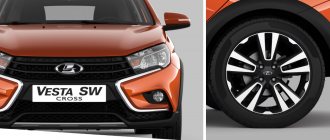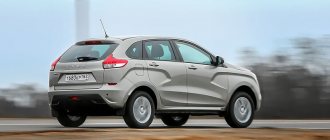April 27, 2019 Lada.Online 18 502 3
Autoreview experts decided to find out whether the Lada XRAY can surpass the Lada Vesta SW Cross. The Chevrolet Niva SUV also took part in the big test. This is the last production all-wheel drive vehicle developed in Tolyatti twenty years ago. In a comparative review, we decided to show what AVTOVAZ could do then - and what it has come to now.
Specifications
| Lada Xray Cross | Lada Vesta SW Cross | Chevrolet Niva | |
| Price | 914,000 rub. | 884,000 rub. | 776,000 rub. |
| Issued from | 2020 | 2020 | 2002 |
| Motor and gearbox | |||
| Engine | petrol / 1774 cm³ | petrol / 1774 cm³ | petrol / 1690 cm³ |
| Power | 122 hp | 122 hp | 80 hp |
| Transmission | mechanical / 5 steps | mechanical / 5 steps | mechanical / 5 steps |
| Drive unit | front | front | full |
| Acceleration to hundreds | 10.3 seconds | 11.2 seconds | 19 seconds |
| Maximum speed | 179 km/h | 180 km/h | 140 km/h |
| Fuel consumption | 9.3 / 5.8 / 7.1 l/100km | 10.7 / 6.4 / 7.9 l/100km | 13.2 / 8.4 / 10.2 l/100km |
| Body | |||
| Ground clearance | 215 mm | 203 mm | 220 mm |
| Dimensions (length × width × height) | 4165 / 1764 / 1645 mm | 4424 / 1785 / 1532 mm | 4056 / 1800 / 1690 mm |
| Trunk volume | 361 l | 480 l | 320 l |
| Fuel tank volume | 50 l | 55 l | 58 l |
| Vehicle weight | 1250 kg | 1280 kg | 1410 kg |
| Safety | |||
| Anti-lock braking system (ABS) | There is | There is | There is |
| Stabilization system (ESP) | There is | There is | unavailable |
| Number of airbags | 2 | 4 | 2 |
| Driver airbag | There is | There is | There is |
| Front passenger airbag | There is | There is | There is |
| Front side airbags | unavailable | There is | unavailable |
53-lifan_zr-02_16
The engine lives up to its stated power - acceleration is brisk. It's a pity that after 4000 rpm his interest sours. The gears were selected successfully, the shift mechanism is quite accurate - no problems. And everything is fine with the brakes (Lifan was the only one in the test with rear disc mechanisms). The average information content of the drive did not allow us to receive the highest rating.
The X50 is not afraid of broken roads, except that the vibrations transmitted to the steering wheel are too much. But you need to be careful: the engine oil pan and the gearbox housing are not covered with anything. And it is contraindicated to turn the steering wheel intensively - during the test, the front wheels repeatedly clung to the arches.
In general, everything is more or less. Apart from sound insulation, it seems to be completely absent. At any speed, be it 40 or 140 km/h, you can hear everything except your own voice. The engine growls, the gearbox shift mechanism clicks. But a pebble flew out from under the wheel into the arch and... I think I heard it plop onto the road.
Conclusion? Chinese cars can be completely consumed, seduced by bright packaging and a pleasant price tag. This might work.
Orange mood
Exterior and dimensions of Lada xRay and Vesta Cross
Vesta Cross has an x-shaped brand design. It is successfully played out with a radiator grille and special stamping on the sides. The plastic body kit perfectly complements the image.
The body length is 4424 mm and the width is 1785 mm. The height of the car together with the roof rails reaches 1532 mm.
Increased ground clearance, 17-inch wheels and black, aggressive-looking bumpers increased the length of the Cross version by 2 cm and the height by 4 mm in relation to the station wagon.
Lada xRay is 4165 mm in length, 1764 mm in width, and 1570 millimeters in height (for more information about the dimensions, read the article Lada X-Ray dimensions).
Compared to its donor Renault Sandero, the Togliatti crossover looks faster and lighter. It has stampings on the sides, and the number of windows on the rear pillars has increased.
27-kalina_zr-02_16
Lada Kalina Cross
- The pseudo-off-road version of the Lada Kalina station wagon debuted a year after the launch of the updated model. It features a plastic body kit and increased ground clearance. There is no all-wheel drive version.
- Gasoline engines: 1.6 l, 8V (87 hp) - from 486,600 rubles, 1.6 l, 16V (106 hp) - from 500,500 rubles. (excluding options).
After the “Chinese”, Kalina produces a memory of the finished product. Well, it looks bright - thanks to the orange color and the “cross” plastic body kit. The interior has also been refreshed with orange touches.
The seat has soft padding and a short cushion, but it distributes the load like a human being and allows you to move for a long time without getting tired. Seat height adjustment is not provided here either, but it is not particularly necessary.
You won't be able to hit the buttons on the steering wheel by chance - they aren't here. The rim of the steering wheel is a bit thin, but it feels comfortable in the hands, and that’s the main thing. What a review! Large windows, impressive mirrors and a high landing allow you to easily monitor the situation around the car and not fork out for parking sensors.
Engine and transmission
If desired, these machines can be equipped with several models of engines, which will result in different indicators:
- Vesta can be equipped with an engine of 106 “horses”, the volume of which will be 1.6 liters, also four cylinders and 16 valves, which will allow it to accelerate to 100 km in approximately 11.30 seconds. With this configuration, X Rey will reach a similar speed in almost 12 seconds.
- The second engine, with a power of 122 horsepower and a volume of 1.8 liters, makes it possible to accelerate to one hundred kilometers in almost 11 seconds.
The transmission of both cars is identical and exists in two variations:
- five-speed manual transmission from French manufacturers;
- domestic robotic automatic transmission.
The differences lie in the engine, namely:
- In Vesta, the first is 1.6 liters and is combined with MT and AMT, the second is 1.8 liters, and only with AMT.
- X Ray has the opposite, and this is its advantage, since its mechanics have the most powerful engine among the VAZ line of cars.
Disadvantages of the VAZ 21214 engine
The disadvantages of the base VAZ 21213 engine are complemented by: Frequent manufacturing defects (defects) in hydraulic supports of valve levers (hydraulic compensators). Due to the low level of technological discipline and technical control at the enterprises of manufacturers of precision pairs for hydraulic mounts, parts are produced with a high number of defects, and when assembling heads at the parent enterprise (machining tolerances are not maintained, foreign objects are present, the clamping of the plunger in the hydraulic mount housing results in non-compliance with the tightening torque when installing into the head). For this reason, if the hydraulic mounts wear out, you have to install a new head complete with hydraulic mounts.
Also interesting: Niva and Chevrolet Niva Tuning Shop from 10:00 to 18:00
The latest engine modifications are equipped with time-tested hydraulic valve lever mounts from INA. From them we can say for sure that the risk of deformation of the housing during tightening is reduced to zero. The photo below shows a new type of hydraulic support (with M 24×1.5 thread) in detail (body, plunger) and in assembly.
Low service life before major overhaul. Saving on the quality of the materials used, along with the unreliability of components, parts and assembly units, negatively affects the reliability of the motor and its service life.
PS Dear car owners! What weak points and shortcomings did you encounter with this engine?
Body
Some drivers choose a car based on the prestige of a particular brand. However, in this case this factor is minimal, since both models are produced by the same company. Many people judge prestige by looking at the body; they differ between Vesta and X-Ray.
Vesta is produced only in a sedan body, but in the near future the plant is preparing to present other versions to the public: a hatchback, a station wagon, a version with increased ground clearance and a car with an extended wheelbase. The latter will be produced in limited quantities, but this version looks more prestigious than the others. Many VAZ car lovers are looking forward to these new items.
"X-Ray" is available for free sale only in the hatchback body. Some people believe that the model is a crossover, but this is not so. For fans of light off-road driving, AvtoVAZ is still preparing a version of the XRAY Cross, which can be considered a full-fledged crossover. Changes in the new product will be minimal: all-wheel drive, increased ground clearance, various body linings and other improvements.
If you like sedan cars, then it is best to choose the Lada-Vesta. If you like “pseudo-crossovers”, the size of which is slightly larger than that of other cars, then it is better to give preference to “X-Ray”. There are no suitable options for station wagon lovers at the moment, but Vesta should soon appear in this body style. The same applies to those who like crossovers for overcoming light off-road conditions. AvtoVAZ is preparing Xray Cross for them.
“Chevy Niva” or “Lada Vesta Cross”: what to choose if you have 800 thousand rubles in your pocket
January 20, 2022 Vladimir Pshenin photo of the creator
For eight hundred thousand rubles you can buy any type of car: Russian or imported, new or used. The choice is enormous, and often it is not easy to decide even on the class of the car. We are now just going to look at cars in different categories - Lada Vesta and Chevy Niva.
Despite the fact that these cars seem to be completely different, they have at least one thing in common: they are Russian developments on Russian platforms. And the saddest thing is that they are, most likely, extreme of their kind. In the future, both passenger cars and all-wheel drive vehicles of the Lada brand risk switching one hundred percent to the platforms of the Renault-Nissan alliance.
Appearance is not the main thing
Two years have passed since the start of sales of the Lada Vesta SW Cross station wagon, and seventeen years have passed since the debut of the Chevrolet Niva model. And not to say that the last one looks like a dinosaur. On the contrary, thanks to the initially measured design “for centuries”, you won’t give it that many years right away. For example, headlights with a black backing and close-beam lenses look very expensive. But Vesta, naturally, is more modern and respectable.
Internal content
It is clear that the Niva is not a driver’s car and does not have an anatomically clear-cut “hugging” seat shape, but it doesn’t need that. “I sit high, I look a little far away” - this is the advantage of the machine. Well, it’s absolutely very comfortable here. Because the seat is placed high, the hips rest one hundred percent on it and do not get tired. The seat, by the way, is height adjustable, as is the steering wheel. There is an elbowrest, but it is not adjustable.
The new composition of the devices, due to the small numbers, is less readable than the previous one, from the “tag”. The multimedia system added not so long ago is, naturally, a step in the direction of modern trends, but with aspects. By the way, we already knew about it.
Rear landing? On the one hand, sitting “behind myself,” I, with a height of 184 cm, touch the back of the front seat. On the other hand, taking into account that the length of the car (without the spare wheel) is less than four meters, the location was used very correctly. In addition, the sofa stands high, does not leave your legs without support, and there is plenty of room wide. The only additional amenities are cup holders, which can be accessed when the driver's armrest is turned over.
Embarrassingly hidden behind the rear seats is what the Chevrolet Niva is criticized for most of all - the trunk. The door to it, by the way, opens in the right direction, with access from the sidewalk, but you won’t be able to find a decent volume there. The height seems to be normal, but the depth of the compartment is too small. For the sake of enthusiasm, I tried to lie down there, but didn’t fit. Well, you won’t be able to spend the night with the seats folded down. And, naturally, Niva owners shouldn’t even dream about additional compartments and other functions.
Maximum configuration
Vesta has in stock:
- alloy wheels;
- mirrors and handles identical in color to the body;
- the ability to adjust the driver's seat to the required height;
- full electrical package.
At the same time, there is a six-speaker multimedia system, air conditioning and a cooled glove compartment, a case for glasses, a mirror in the visor above the passenger seat, climate control, a heated windshield and illuminated doors when exiting. In a word, the sedan has luxury equipment.
X Rey has similar parameters, but in addition there are:
- fog lights;
- a drawer under the front passenger seat that can be pulled out;
- double floor in the trunk;
- power mirrors and heated glove box;
- heavily tinted rear windows.
In conclusion, it must be said that it is quite difficult to choose a leader between these cars. They have quite good characteristics and both are suitable for driving on Russian roads. It all depends on the specific buyer’s requirements for the car. Although Vesta is more suitable for city trips, while X-Ray is more suitable for driving on country roads.
Main overall dimensions and appearance
Both models are made in the same stylish design with a pronounced letter X on many parts of the cars. The head optics and the front part of the body with the radiator grill are practically the same
Identical X-shaped stampings on the fenders and doors of cars attract the attention of others. The interior and ergonomics of the cabin have minor differences
Comparison of Lada Vesta with Lada X Ray Both of these models cannot be compared on the same scale
First of all, they are made in different body types, which means that a comparative analysis must be carried out taking into account this important design difference
| Options | Lada X-Ray | Lada Vesta |
| Length/width/height (mm) | 4165/ 1764/ 1570 | 4410/ 1764/ 1497 |
| Wheelbase (mm) | 2592 | 2635 |
| Body/number of doors | Crossover/5 | Sedan/4 |
| Ground clearance (clearance) (mm) | 195 | 178 |
| Luggage compartment volume (l) | 361 | 480 |
| Curb/maximum weight (kg) | 1190/1650 | 1230/1670 |
| Fuel tank volume (l) | 50 | 55 |
The X Ray crossover, thanks to its significant ground clearance and short wheelbase, has advantages on roads with worse surfaces and on poor off-road conditions. In terms of dynamic characteristics, it loses to the more stocky and streamlined Lada Vesta sedan, whose center of gravity is lower and stability on the highway is much better than its competitor. If you compare the Lada Vesta in city traffic on the asphalt, in terms of maneuverability it is not much different from the X Ray.
Two old men. Comparison of Lada 4×4 and Chevrolet Niva
Autumn is coming to an end - it's time to put some mud on the jeep. If you have one, of course. And if you are not yet completely old for such rides.
In the autumn of 2022, the editorial office immediately found several all-wheel drive cars. A couple can completely be called old people, these are Lada 4x4 and Chevrolet Niva. There was also the Renault Duster, which we conducted a comparative test with the Chevrolet Niva in company with bloggers from “Normal View”.
We were faced with the usual task of understanding how the “ordinary Niva” differs from the Chevrolet Niva. After all, it’s worth admitting that if you want to buy a comfortable all-wheel drive car without mileage, costing no more than 850,000 rubles, you will still look at both options, often not finding a fundamental difference. And she is.
A laconic excursion into the past
Both cars are the development of AvtoVAZ, dating back to the last century. Chevrolet Niva is essentially an advanced version of the VAZ Niva (Niva-2 project, model 2123), transferred to the Russian-American joint venture GM-AVTOVAZ (not to be confused with AvtoVAZ) in 2001.
The period 2013-2017 became that segment of the current car cycle when all possible extreme configurations were introduced that did not require expensive interventions in the body, platform, exterior, interior and power units. Cars have been modernized before.
Chevrolet Niva differed in some ways at the beginning; something, usually faster than its progenitor, was introduced year after year. The configurations of the two cars mostly relate to environmental standards, individual engine and timing components, transfer case, vibration and noise reduction, and chassis.
The engine and gearbox, apart from minor differences in details, are similar. The interior and some exterior details were changed point by point. The engines and gearbox remained constant, although engineers also dug into them. And here in front of us are two almost similar, almost Russian jeeps.
Feelings from driving
Before we get behind the wheel of a car, we inevitably see it. It hurts at times. Here the visual memories are similar. Not to say that either of them is very scary, but neither of them shine with beauty and originality. Lada 4x4 has the most aggressive shapes. Chevrolet is completely suitable for work trips, and after washing and hanging ribbons and balls on it, there is no shame in driving around with your wife.
Characteristics of gearboxes
Both cars have identical transmissions. Both models have an AMT-type robotic gearbox and a pair of five-speed manual ones. The only difference here is that Vesta can be equipped with either a domestic or French transmission. X-Ray only has French ones.
In general, the gearboxes operate smoothly, without gear slippage or unpleasant noise. What’s typical is that you won’t find a classic automated gearbox on any model. In order to save money, a robotic gearbox was installed, which affects the ride - more jolts and jerks, a delayed reaction to reverse gear. However, you can get used to it.
Transmission and engine
Vesta Cross has only one uncontested 1.8 liter engine with 122 horsepower. At the limit of its power it produces 170 torque. And per hundred it consumes only 7 liters of gasoline. The car is equipped with a robotic transmission with ZF components.
The xRay model is available in two engine types. They are both petrol. The 1.6-liter engine produces 106 horsepower and 148 Nm of torque (more details here: What engine is on the Lada X ray).
The 1.8 liter engine produces 122 horsepower and contains 170 N/m of torque. Two transmission options: five-speed manual and robot (read more here: Gearbox x ray).
Comparative test drive of Lada X-RAY with competitors - who is better?
Comparison of domestic bestseller with foreign manufacturers
Lada X-RAY is the most unexpected premiere of 2016. But can he become popular and in demand? To do this, it was compared with some cars, namely Kia Rio, Renault Sandero Stepway, Nyundai Solaris, Ford Fiesta.
Design
Beauty is a subjective thing and giving scores would be pretty meaningless. If we compare design elements, then in terms of expressiveness of the exterior only the Nissan Zhuk can probably compare with the Lada X Rey.
Also, the domestic crossover can be placed on the same level as the Mitsubishi ACX. Here you can compare high ground clearance, good proportions, and the presence of a completely combative appearance.
Lada XRAY vs Renault Sandero Stepway
Dimensions
With a length of 4.2 meters and a wheelbase of 2.6 meters, the Lada XRAY is noticeably larger compared to the outsider Cherie India. It does not reach 4 meters in length, and the small wheelbase makes the car a class lower. In addition, the Ford Fiesta will be a bit cramped compared to the Lada. But if we speak for the Mitsubishi ACX, then it is the undisputed leader compared to all the cars listed above.
Motor
The Lada X Ray is presented in three engine options, which the Renault Sandero Stepway, which has only two options, cannot compare with. Kia Rio and Hyundai Solaris are also available in two versions. Only the Ford Fiesta, which has three engines with very similar horsepower, can compare with the new 2016 model. A comparative test of the Lada X Ray with its competitors showed that the car can compete with dignity in the auto market.
AVTOVAZ News No. 10
Engine characteristics
As for engines, the Lada X-Ray still has the advantage. The manufacturer offers a choice of 3 engines at once, which cannot be said about the Lada Vesta, since there is no choice here, and only one engine is offered.
If we talk about general features, then for both cars a domestic engine of the VAZ-21129 series is produced. Engine power is 106 horsepower. The unit has a reliable and simple design: 4 cylinders and 16 valves, as well as a distributed fuel injection complex.
- The Lada Vesta can be accelerated to 100 km/h in 11.2 seconds, the X-Ray in 11.4 seconds, despite such a small power.
- As for the maximum speed, the difference is small. X Ray overtakes Vesta by 1 km/h (176 versus 175 km/h).
- Fuel consumption also has a slight difference: Vesta - 9.3/6.9/5.5 liters, X-Ray - 9.3/7.2/5.9 liters.
However, Lada X-Ray can offer its customers several more engines with 110 and 122 horsepower. The first option reaches speeds of up to 184 km/h and has a volume of 1.6 liters. The second one is a little more powerful: the maximum speed here reaches 186 km/h, the volume is 1.8 liters. As for fuel consumption, it is almost the same for both cars.
TTX Lada x Ray
Interior of Lada X-Ray and Lada Vesta
As for the interior decoration of the models, it produces a pleasant effect. The cars look quite impressive, it is worth noting that the similarity of the models is immediately noticeable. The general style of the dashboard, a dashboard with wells, elongated air deflectors, a center console, almost the same steering wheel, comfortable seats, a rear sofa with a harmonious profile.
Salon X Ray
Salon Vesta
In addition, cars have such a positive quality as visibility. The side mirrors are large enough to allow you to clearly see the situation behind you.
Don’t forget that Vesta is a sedan, so there is quite a bit more space in the rear cabin. X Ray wins with his height.
Main overall dimensions and appearance
Both models are made in the same stylish design with a pronounced letter X on many parts of the cars. The head optics and the front part of the body with the radiator grill are practically the same
Identical X-shaped stampings on the fenders and doors of cars attract the attention of others. The interior and ergonomics of the cabin have minor differences
Comparison of Lada Vesta with Lada X Ray Both of these models cannot be compared on the same scale
First of all, they are made in different body types, which means that a comparative analysis must be carried out taking into account this important design difference
| Options | Lada X-Ray | Lada Vesta |
| Length/width/height (mm) | 4165/ 1764/ 1570 | 4410/ 1764/ 1497 |
| Wheelbase (mm) | 2592 | 2635 |
| Body/number of doors | Crossover/5 | Sedan/4 |
| Ground clearance (clearance) (mm) | 195 | 178 |
| Luggage compartment volume (l) | 361 | 480 |
| Curb/maximum weight (kg) | 1190/1650 | 1230/1670 |
| Fuel tank volume (l) | 50 | 55 |
What is good about the Chevrolet Niva
We will not go into technical specifications, comparing what the difference is between these cars. Niva Chevrolet or Niva 2121 – which is better? Owner reviews will help us understand this.
So, according to many, the Chevy Niva does not accelerate very quickly. The reason for this is the not very good aerodynamic performance of the car. Added to this is the rather inert steering, which is not designed for making sharp turns on an asphalt road. But the braking system works much better than that of the three-door Niva. The ergonomics of the cabin are also better. The various control buttons are conveniently located, and they also have their own backlight. For the driver's convenience there is a comfortable armrest. The cabin is warm and not noisy, thanks to a well-functioning heating system and available sound insulation. The suspension provides a smooth ride. All this allows the driver to feel quite comfortable on long trips.
In addition, the Chevy Niva's cabin has excellent visibility, although the rear wheel eats up some of the viewing area. The side mirrors do not have the disadvantages that the Niva 4x4 has: their position does not change when driving on uneven roads.
I would especially like to note the spacious trunk. Its volume commands respect even with the rear seats up.
Well, a little catch: the driver needs to turn on the differential in this model (unlike the VAZ-2121) in advance, before overcoming the obstacle. Problems may arise when transporting, towing or pulling out of mud. The hijack can only be hooked onto the wheels of a car, and the openings for the jacklas are small.
The Chevrolet Niva is more expensive than its relative, the cost of spare parts and body kits for it is also high.
Engine characteristics
As for engines, the Lada X-Ray still has the advantage. The manufacturer offers a choice of 3 engines at once, which cannot be said about the Lada Vesta, since there is no choice here, and only one engine is offered.
If we talk about general features, then for both cars a domestic engine of the VAZ-21129 series is produced. Engine power is 106 horsepower. The unit has a reliable and simple design: 4 cylinders and 16 valves, as well as a distributed fuel injection complex.
- The Lada Vesta can be accelerated to 100 km/h in 11.2 seconds, the X-Ray in 11.4 seconds, despite such a small power.
- As for the maximum speed, the difference is small. X Ray overtakes Vesta by 1 km/h (176 versus 175 km/h).
- Fuel consumption also has a slight difference: Vesta - 9.3/6.9/5.5 liters, X-Ray - 9.3/7.2/5.9 liters.
However, Lada X-Ray can offer its customers several more engines with 110 and 122 horsepower. The first option reaches speeds of up to 184 km/h and has a volume of 1.6 liters. The second one is a little more powerful: the maximum speed here reaches 186 km/h, the volume is 1.8 liters. As for fuel consumption, it is almost the same for both cars.
TTX Lada x Ray
Comparison of platforms
The main difference between the new generation of VAZ products is the technological platform. The Xray is based on the Renault Sandero platform, but has received a retuned suspension with different springs, a slightly wider track and strengthening of some components. Hydraulic power steering gave way to electro-hydraulics, and the ABS system was provided by Bosch.
In turn, Vesta flaunts a completely new platform, developed specifically for Russian operating conditions. Here, as on the raised hatch, MacPherson struts are used at the front and a torsion beam at the rear; subframe for engine mounting; lower location of the steering rack; and electro-hydraulic power steering from Nissan.
At the same time, the new platform is more resistant to temperature and mechanical loads, and the body structure includes special reinforcement zones, allowing one to expect a higher result in EuroNCAP crash tests. According to AvtoVAZ's expectations, the X-ray should receive three stars, like its French platform brother, but Vesta expects at least four.
38-kalina_zr-02_16
Driving does not evoke the brightest feelings. 100 6 forces are almost one hundred percent dissolved into boxes - the VAZ bot is thoughtful when switching. In general, this is a corresponding feature of all transmissions of this type. A modern automatic or transmission with 2 clutches would solve the problem, but it is incredibly expensive.
And in terms of acoustic comfort, the Cross is far from the standard: the engine is well insulated, but the “noise” of the arches and bottom is unimportant, and extraneous sounds are heard through the door seals.
In general, you won’t get any spirited drive from Kalina. But how good it is in our “directions”, be it broken asphalt or a primer! It simply “smoothes out” small bumps and allows you to confidently rush through the pits. I wish I could “untie” the steering wheel from the road! He, like Lifan, receives tangible shocks.
Prices for new AvtoVAZ products
Prices for Lada Vesta and Lada X Ray are displayed in detail on the official website of Lada cars. The significant difference in price from the basic configuration to its maximum performance is explained by the large number of options and generous equipment of the car. How much this or that modification will cost depends on the buyer’s preferences.
Basic equipment
Lada Vesta with the most modest Classic equipment and a base engine paired with a manual transmission will cost the buyer 545,000 rubles. The list of equipment already includes all the necessary safety systems for skidding and loss of control, two airbags and some pleasant little things for comfortable driving.
The cost of the X Ray in the minimum Optima configuration with the same engine and manual transmission starts from 600 thousand rubles. The equipment of the crossover is distinguished by the presence in the “base” of an installed audio system with speakers and modern functionality. In addition, X Ray is equipped with electric power steering, unlike Vesta’s electric power steering.
Maximum configuration
Prices for the new Vesta in Moscow with a “robot” and a more powerful engine start at 650,000 rubles for the average Comfort equipment. The maximum list of Luxe/Multimedia options will cost 735 thousand.
Differences between cars in the interior Similar equipment of a crossover in the average Luxe configuration will cost 760,000 rubles. The price of the top version Exclusive will be 830 thousand. The crossover has a more generous package, which includes:
- interior lighting;
- presence of an additional socket in the trunk;
- 17" alloy wheels;
- double luggage compartment floor;
- folding rear seats that create a flat surface for carrying additional luggage;
- leather trim of the gearshift knob and steering wheel;
- the presence of an additional box under the front passenger seat;
- original design of seats and interior Exclusive.
The presence of additional options and the advantage of a 5-door off-road explains why Khrey is more expensive than Vesta. After watching numerous videos where two models are compared directly under the conditions of their actual use, you can decide which car you should buy, taking into account individual preferences.
Full photo gallery of Chevrolet Niva&Lada 4×4 » » »
As much as I would like to say something similar about the Lada 4×4, it doesn’t work out. Everything in the cabin is absolutely budget-friendly. The steering wheel is without adjustment, the heater unit with analog temperature and flow switches, which today’s generation perceives as a set of hanger levers. Foreign-located air conditioner controls... Gearbox lever (Checkpoint - a point designed to control passage (visit) and access to the territory of any facility)
, which, having sat moderately comfortably in a chair, you have to reach for. And noise. Lots of noise.
The ride of the cars is soft, the suspension works unsurpassed on bumps and when passing speed bumps. Here you get real pleasure. When driving on the highway, the Chevrolet Niva feels more confident. There is no longitudinal swing, which is justified by a different weight distribution, a few centimeters of the wheelbase and changes in the suspension.
There is no particular difference here, unless you take into account the presence of a snorkel in some Chevrolet trim levels and a different placement of components in the engine compartment - the spare tire is on the rear door, and not, like the Lada, under the hood.
Both Shniva and Niva fully justify the status of jeeps, without having a frame, as ardent adherents of preserving terminology may recall to us.
The only difference that a driver who decides to play with the lowering range and locks will encounter is with Chevrolet, not counting the checkpoint selector (Checkpoint - a point designed to control passage (visit) and access to the territory of any facility)
, another lever, and the traditional Niva has two of them. GM-AVTOVAZ has combined the functions of locking the center differential and controlling the reduction row, which is even more convenient to use and more aesthetically pleasing. All drives are permanently all-wheel drive.
We tested both cars on the same route, where we had driven a Duster 2 days earlier. Watery mud up to the middle of the wheel, bumps hidden under water, dirt roads and sandy climbs cut by tree roots - this is not the kind of off-road that you want for the greatest experience. But these are the conditions in which most of these cars live for decades.
Prices and options
You can purchase a Chevrolet Niva in the showrooms of official dealers at prices ranging from 687,000 rubles for the L trim level, to 819,000 rubles for the highest GLC. In total, the manufacturer provides 6 configurations, differing in the cover or plastic spare tire box, heating and adjustments, the presence of certain parts of the exterior and interior, multimedia, window tinting, wheels, snorkel, the presence of roof rails and a standard towbar.
The VAZ car has four trim levels - Classic for 523,900 rubles, where, for convenience, only front windows are the bare minimum. Black Edition is the largest for a three-door car. For this they demand 579,900 rubles. And it has mirror adjustment, air conditioning (also available on the cheapest trim levels), the most prestigious composition, heated and heated mirrors and front seats, and light tinting. Neither a radio nor multimedia is included in any of the configurations. Audio preparation only.
Thus, “at minimum wage” we get a difference of 163,000 rubles, which we definitely pay extra for convenience features, great safety (two airbags in Chevrolet, not one in Lada) and the most spacious interior. Some will also note the exterior design of Chevrolet. Having forked out more, you can buy a jeep that already meets the average requirements of convenience, which cannot be said about the Lada 4x4, in which you only pay extra for air conditioning and a couple of heating units.
Judging by my own driving experience, as well as from comments and reviews on the Internet, the main problem with the Chevrolet Niva is its weak engine. Yes, 80 rated horsepower is enough on asphalt straights with an empty interior. But this is terribly not enough with a full interior, uphill, along the sand.
There are no such heated discussions about the unit (83 hp) of the Lada 4×4. She is expected to configure virtually everything. And, as we know, an update will come. Only it will not be a Russian car, but a car on the B0 platform, which is not at all disgusting. We would have kept all-wheel drive. At the moment, the VAZ jeep is the model that brings the highest percentage of margin to the manufacturer. There are no expensive upgrades; engineering costs were recouped in the last century. But the Lada 4×4 definitely looks different from the entire brand line, put in order by designers, advertisers and engineers. It is in no way permissible to associate the level of properties and equipment of Vesta and the traditional Niva.
The editors thank the CM-AVTOVAZ press service for the cars provided for the test.
Source: journal.a-b63.ru
Motors for every taste
The engine range and gearbox list for the new products of the Volga auto giant will be as unified as possible, but the sedan will receive a slight advantage due to the presence of the youngest engine with a volume of 1.6 liters and an output of 87 hp. Otherwise, the range of engines is the same: two 1.6-liter engines (domestic with a capacity of 106 “horses” and a French one with an “exhaust” of 114 hp) and a top-end 1.8-liter unit capable of producing 123 hp. power.
Engine compartment of Lada X Ray
All of them are offered with a 5-speed “mechanics” of French origin and a domestic “robot” with control mechanisms from ZF. In addition, for the top-end engine, VAZ will also offer an optional Japanese “variator”, but this will happen approximately in the middle of next year.
45-lifan_zr-02_16
Lifan X50
- The pseudo-off-road hatchback Lifan X50 has been on sale since the summer of 2015. Built on a common platform with the Lifan Celliya sedan. There is no all-wheel drive version.
Engine: petrol 1.5 l (103 hp) - from 499,900 rubles. (excluding options).
From the outside, the Lifan X50 is completely fine, although there is a bit of plagiarism: you can feel the motifs of the Opel Mokka crossover in it. It's a pity, the gray color neutralizes the aspects of the body lines. The interior is also 50 shades of grey. Only the red composition of the devices catches the eye.
A beautiful wrapper does not guarantee a delicious filling. Ergonomics will appeal only to fans of the aforementioned sensational novel who prefer an original pastime. The leatherette-covered driver's seat is set high and does not have a microlift. The lateral support rollers are very close together and rest unpleasantly on the lower back: after half an hour, the back begs for mercy. For drivers over 170 cm tall, part of the view is blocked by the ceiling falling towards the windshield.
The steering wheel has a good cross-section, but is trimmed with very slippery plastic, and the audio system control keys are located almost on the rim - I unintentionally pressed them several times. Against this background, you forgive other strange decisions. For example, blind buttons for heated seats at the end of the cushion or handwheels for adjusting temperature and airflow intensity sitting on a common axis.
Platforms
For the sedan, it is a combination of engines produced by VAZ with gearboxes from Russian and French manufacturers. Also available is a body with a subframe, long stabilizer bars and rear suspension.
As for the X Rey, it is designed on a joint Renault-Nissan platform. It has a simple design with Russian engines and French MT and AMT. It was also equipped with a monocoque body, which has a very large subframe, which is a kind of protection for the engine.
The hatchback platform is reliable, versatile and is 100% suitable for Russian roads, which Vesta cannot boast of.
Design
It’s worth noting right away that today’s article will not talk about the second generation of the Chevrolet Niva, which has been repeatedly mentioned on various resources since 2014. The second generation is already considered in fact “dead”; the manufacturer abandoned it due to financial problems and possible problems in sales, since the price had to rise by at least 40%.
As for the appearance of the first generation, it should be noted that there were two restylings, the last of which was presented in 2009. Judging by the photos and videos, the car has grown a little in size, more expressive outlines of the body have appeared, the shape of the optics has changed very slightly and nothing more. The overall outline remains recognizable.
Of course, it is difficult to fully compare it with other SUVs, since there are really no competitors in this price range. The appearance is unprepossessing, one might even say simple, but at the same time the appearance is practical and versatile. In any case, the brainchild of the joint concern is much more attractive than the familiar Niva from the 1980s, which, by the way, is still produced today, which is already strange, given its more than 40-year history without major transformations. But, let’s return again to the Chevrolet Niva, what kind of car is this, how does it attract and captivate buyers?
Exterior
Chevrolet Niva has an unsightly appearance, but is still popular, the main reason lies in its unique off-road qualities, as well as its relative cheapness.
The front appearance is distinguished by a massive bumper, with aluminum or metal protection; there is sufficient overhang, so you don’t have to worry about overcoming any obstacles. At the edges of the bumper there are a couple of foglights and a small horizontal branching of the air intake, presented with a conventional mesh shape.
In profile, the Niva looks neat, more like a trim hatchback than a real SUV. One of the innovations of the Chevrolet Niva 2022 and years earlier is a roof rail installed on the roof, which gives a certain masculinity and aggressiveness to the appearance. The only thing in the “base” is that the wheels are small; after all, the 15-diameter is too small. The rest of the body proportions and the same ground clearance are quite decent.
As for the rear part of the Chevrolet Niva, here, for the sake of the off-road segment, they decided to install a spare wheel on the door; it looks really powerful and confident. The design of the taillights is interesting with a certain theme and reference to history. The bumper overhangs, as in the case of the front part, allow you to enjoy all the advantages of an SUV, both in the city and outside the city.
Interior
The interior of the Niva Chevrolet can hardly be called spacious; nevertheless, it feels like the car has remained on the same old platform. The discomfort is felt to a greater extent at the back, including due to the poor angle of the backrest. Not everyone has the patience and strength for long trips. However, if we look at the front seats, for example, the driver’s, it is quite an ergonomic and well-thought-out space. Moreover, the center console can even be rotated, making all the functionality available to the driver.
It is worth noting that starting in 2014, Chevrolet installed modernized seats with additional support at the edges. The positive part is the luggage compartment, if the “ancestor” Chevrolet Niva had questions with this, then the new Niva has a luggage compartment that allows you to fit a lot of luggage. Available in the “base” 320 liters, which can easily be converted into 1,300 liters if you fold the rear row of seats.
An important plus is that the trunk has no threshold, which even top-end SUVs suffer from. And the door is wide, you can even load large items.
Just pure hell: how the Chevrolet Niva is crumbling. Owner's review
After an ordinary Niva I switched to a Chevy, the memories are very bad.
I got a Chevrolet Niva in “tundra” color in 2016. Previously, there was also a Niva, but ours, 2013, but after driving about 30 thousand km on it without any particular problems, I decided to use the trade-in and exchange it for a fresher car.
At first, looking at the Chevy Niva outside and inside, it really seems that, in comparison with its predecessor, the car has become more attractive and better. But such positive feelings were not destined to last long - exactly until the moment I got behind the wheel and drove off.
Yes, it still became a little quieter in the cabin, but after the first 2 thousand runs, the realization came that this Niva remained the same: it still moves with difficulty, everything in it is {filled} with a rumble, and the gearbox is switched on with a certain effort . Surprisingly, I was pleased with the assembly quality of the interior; there are no cracking or rattling parts in it. Otherwise, when you go out on the highway, you have to listen to the howling gearbox, the knocking of the shafts at the moment of gear shifting and the roar of a weak engine. As for the extreme, besides the fact that he does not want to move at all, he also consumes oil and gasoline with a majestic appetite. I had to add 200 grams of oil every 10 thousand kilometers, yet the ancient Niva achieved nothing from replacement to replacement.
Having not yet reached the “zero” maintenance, I was getting ready to go on a trip to the countryside, drove the car to the house, loaded it up, got ready to leave, but it wouldn’t start, I could only hear clicks. Several attempts to start it, of course, yielded nothing. I had to ask my neighbor to drive his car and “light” the Niva. It was difficult and not straight away, but we succeeded. What it was remained unclear, but the alarm could not be affected, the battery was new. And all this with only a couple of thousand kilometers covered.
I drove further, reached 4.5 thousand mileage, again the situation repeats itself, again I have difficulty starting, but this time accompanied by the Check Engine light. In anger, once at home, I call the dealer. He agreed to take a look and solve the problem (it seemed like he understood what the problem might be), noting that there was nothing terrible about it. The trick is that before the service I need to drive another 200 km. Okay, I get there, they change the oxygen sensor at the service station and it seems like they solved the problem. At the same time, we checked the voltage drop in the network - everything is fine.
At approximately 8 thousand kilometers, on a cool start and at idle, the engine began to rattle, but what exactly was rattling in it could not be made out. Maybe hydraulics, or maybe a hydraulic tensioner, but obviously there were aspects with oil pressure. The dealer did not reveal anything or was not willing to do so. Since the knocking went away as the engine warmed up, I put up with it.
The mileage is 22 thousand: there is no longer a guarantee and again the Niva starts poorly and is intimidated by the “Chek Engine”. The service turns out that now it is necessary to change the phase sensor. The substitution produced results, but from now on the Niva began to behave unpredictably: it wanted to start, it wanted to - no, the pointers to the devices worked on their own, the engine did not start, every other day I had to start it with a pusher. And all this happens with virtually the newest car, with a mileage of 22 thousand km. Replacing the battery did not help, replacing the starter solenoid relay also had no effect, the source of the problem was never found, even though all the components were changed one by one.
One shock absorber is sentenced to approximately 30 thousand, but in fact I always only drove around the town. In addition, when it was cool, there was a rumble in the power steering.
In general, I decide to get rid of this “cramp”, quickly (surprisingly) sell it and hope that the new owner’s car will start normally. Now I can say that you shouldn’t listen to positive reviews about the Chevy Niva: the car is definitely not worth your own money and only causes difficulties. It doesn’t matter which other ancient foreign car will be better in operation and you won’t have to constantly listen to the noises made by the machine so as not to miss the moment when something in it falls off here and there.
Why do Chevrolet spoil their reputation for being such an inferior car? I came in at the moment for enthusiasm to look at the prices for it: from 623 to 757 thousand! For these funds, take a Vesta Cross or X Ray, if you need all-wheel drive, then an ordinary Niva, at least you know what to expect from it, plus it is mega undemanding. The Chevy Niva has only one advantage over it - its appearance. All.
If you do decide to drive a Chevy Niva, go straight to a competent service center and get ready to replace all the silent blocks, the hydraulic tensioner, and the standard battery!
Source: www.lada-vesta2.ru
Characteristics of gearboxes
Both cars have identical transmissions. Both models have an AMT-type robotic gearbox and a pair of five-speed manual ones. The only difference here is that Vesta can be equipped with either a domestic or French transmission. X-Ray only has French ones.
In general, the gearboxes operate smoothly, without gear slippage or unpleasant noise. What’s typical is that you won’t find a classic automated gearbox on any model. In order to save money, a robotic gearbox was installed, which affects the ride - more jolts and jerks, a delayed reaction to reverse gear. However, you can get used to it.
Test results
Expert assessments were given based on a number of criteria.
Dynamics. Vesta accelerates and turns more pleasantly than anyone else. The Niva is slow, but its connection to the gas pedal is much clearer than that of the more dynamic XRAY, which is uncomfortable to drive. Equal scores with the Niva for handling are associated only with the lack of a stabilization system on the Niva - the chassis itself is better tuned. In terms of cross-country ability, there is no equal to the Niva.
Ride comfort. Despite the additional sound insulation of the Cross version, XRAY turned out to be noisier than Vesta due to the disgusting sound of the engine. Niva in the “civilian” version without a snorkel does not frighten with unnecessary noise at all permitted speeds and is noticeably superior to Crosses in terms of smoothness.
Comfort in the cabin. Vesta is longer than the others and, as expected, wins over everyone in terms of rear space and trunk volume. And the compartment is well thought out. The Xray and Niva are all more modest, and the Chevrolet transformation is from the last century: to recline the backs of the rear seats, you first need to raise the pillows.
As a result, the total score was calculated, which determined the winner:
Do you agree with these assessments?
Let us remind you that we previously talked about how the Lada Vesta Cross and Lada XRAY Cross withstood the Karakum route (9000 km).
Packages and additional equipment
- Metallic paintwork RUB 6,000
- Front bumper protection RUB 8,063
- Hood deflector RUB 1,767
- LED flashlight with LADA logo 565 ₽
- Fender liner set RUB 1,712
- Parking assistance system from RUB 2,370
- Set of door sills RUB 2,277
- Set of covers for storing wheels R13-R16 RUB 3,788
- Universal trunk loading carpet RUB 2,575
- Trunk assembly RUB 2,349
- Towbar (without electrical wiring) RUB 4,594
- All extras
https://xraycars.ru/lada-xray-otzyv-vladelca-shevi-niva/https://www.zr.ru/content/articles/901020-shevrole-niva-ili-lada-4kh4-naj/https: //ladaprofi.ru/novosti/pochemu-lada-vesta-luchshe-chem-lada-h-rej-iv-chem.htmlhttps://naavtotrasse.ru/vibor/niva-shevrole-ili-niva-4h4.htmlhttps: //carsdb.ru/comparsion/cars/145-152/











